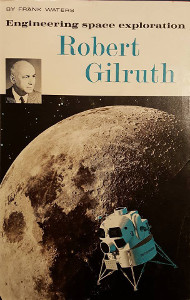Engineering Space Exploration: Robert Gilruth

Author:
Frank Waters
Publication:
1963 by Encyclopædia Britannica Press
Genre:
Biography
Series:
Britannica Bookshelf: Great Lives for Young Americans / Compton Bookshelf: Great Lives / Bookshelf for Young Americans ![]() Members Only
Members Only
Current state:
This book has been evaluated and information added. It has not been read and content considerations may not be complete.
Book Guide
Search for this book used on:
Most boys have been fascinated by flight. They have built model airplanes, flown them, tested them, tried to improve them. Robert Gilruth was a typical young flight enthusiast with a difference: he wrote away to NACA (the National Advisory Committee on Aviation) for technical papers; he devised his own plans for model planes. His mother and father were teachers and an aunt was a scientist, and it was foregone conclusion that Robert would be an engineer or a scientist. At the University of Minnesota, he studied aeronautical engineering and also met his wife-to-be, the only girl among his classmates.
When he had completed his schooling, he applied for a job with NACA and was hired. He studied airplane safety, devised methods of testing supersonic models before the days of adequate wind tunnels, mastered the theory of aerodynamics, and made technical discoveries. Even in his hobby, boating, he carried over knowledge from his job. When he found his own boat too slow, he applied aeronautical principles to create a hydrofoil system that sent it flying.
During and after World War II, the push was on to send men higher and faster in planes, and Gilruth and his engineers and scientists were in the van of research and development of new techniques, new materials, new ideas. When man burst into space and NACA became NASA (the National Aeronautics and Space Administration), Gilruth was put in charge of Project Mercury, planning and carrying through the putting of man into orbit. He and his NASA team did it, working surely and methodically with men and machines, losing no lives despite the frantic pressures put on them to race the Russians into space, and doing all of this with the eyes of the whole world on them.
After Project Mercury, Project Gemini is to come: putting two astronauts into orbit in a larger spacecraft; and after Project Gemini, Project Apollo: putting men on the moon.
For Gilruth and his team at the Manned Spacecraft Center in Houston, this whole grand design is a challenge to be met calmly, methodically, efficiently—drawing everything together for the adventure out into the universe.
From the book
Please sign in to access the type of illustrations and view more books with this type.
Content Guide
Please sign in to access all of the topics associated with this book and view other books with the same topics.
Please sign in to access the locations this book takes place in and view other books in the same location.
Please sign in to access the time periods this book takes place in and view other books in the same time period.
Find This Book
Search for this book used on:


